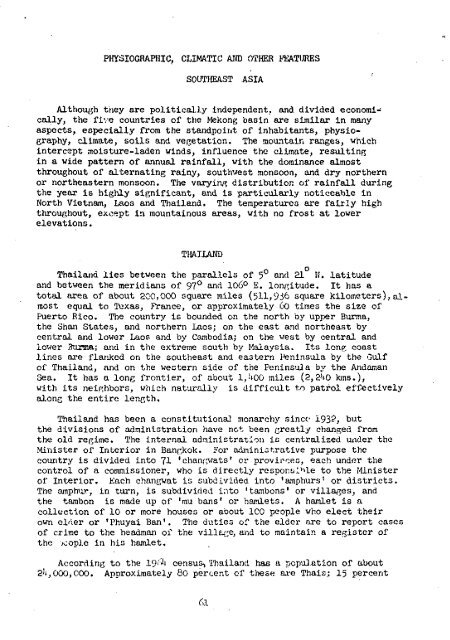Vegetation of Southeast Asia Studies of Forest Types 1963-1965
Vegetation of Southeast Asia Studies of Forest Types 1963-1965
Vegetation of Southeast Asia Studies of Forest Types 1963-1965
You also want an ePaper? Increase the reach of your titles
YUMPU automatically turns print PDFs into web optimized ePapers that Google loves.
PHYSIOGRAPHIC, CLIMATIC AND OTHER FEATURES<br />
SOUTHEAST ASIA<br />
Although they are politically independent, and divided, economically,<br />
the five countries <strong>of</strong> the Mekong basin are similar in many<br />
aspects, especially from the standpoint <strong>of</strong> inhabitants, physiography,<br />
climate, soils and vegetation. The mountain ranges, which<br />
intercept moisture-laden winds, influence the climate, resulting<br />
in a wide pattern <strong>of</strong> annual rainfall, with the dominance almost<br />
throughout <strong>of</strong> alternating rainy, southwest monsoon, and dry northern<br />
or northeastern monsoon. The varying distribution <strong>of</strong> rainfall during<br />
the year is highly significant, and is particularly noticeable in<br />
North Vietnam, Laos and Thailand. The temperatures are fairly high<br />
throughout, except in mountainous areas, with no frost at lower<br />
elevations.<br />
THAILAND<br />
Thailand lies between the parallels <strong>of</strong> 5° and 21 N. latitude<br />
and between the meridians <strong>of</strong> 97° and 106° E. longitude. It has a<br />
total area <strong>of</strong> about 200,000 square miles (511,936 square kilometers), almost<br />
equal to Texas, France, or approximately 60 times the size <strong>of</strong><br />
Puerto Rico. The country is bounded on the north by upper Burma,<br />
the Shan States, and northern Laos; on the east and northeast by<br />
central and lower Laos and by Cambodia; on the west by central and<br />
lower Burma; and in the extreme south by Malaysia. Its long coast<br />
lines are flanked on the southeast and eastern Peninsula by the Gulf<br />
<strong>of</strong> Thailand, and on the western side <strong>of</strong> the Peninsula by the Andaman<br />
Sea. It has a long frontier, <strong>of</strong> about 1,^00 miles (2, 2'fO kms.),<br />
with its neighbors, which naturally is difficult to patrol effectively<br />
along the entire length.<br />
Thailand has been a constitutional monarchy since- 1932, but<br />
the divisions <strong>of</strong> administration have not. been greatly changed from<br />
the old regime. The internal administration is centralized under the<br />
Minister <strong>of</strong> Interior in Bangkok. For administrative purpose the<br />
country is divided into 71 'changwats' or provinces, each under the<br />
control <strong>of</strong> a commissioner, who is directly responsible to the Minister<br />
<strong>of</strong> Interior. Each changwat is subdivided into 'amphurs' or districts.<br />
The amphiir, in turn, is subdivided into 'tambons 1 or villages, and<br />
the tarnbon is made up <strong>of</strong> 'mu bans' or hamlets. A hamlet is a<br />
collection <strong>of</strong> 10 or more houses or about ICO people who elect their<br />
own elder or 'Phuyai Ban'. The duties <strong>of</strong> the elder are to report cases<br />
<strong>of</strong> crime to the headman <strong>of</strong> the village, and to maintain a register <strong>of</strong><br />
the x:ople in his hamlet.<br />
According to the 19^4 census, Thailand has a population <strong>of</strong> about<br />
2't-,000,000. Approximately 80 percent <strong>of</strong> these are Thais; 15 percent<br />
6.1
















